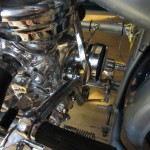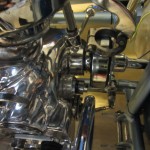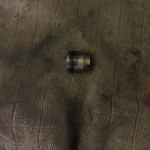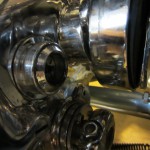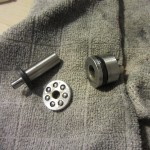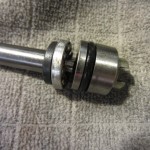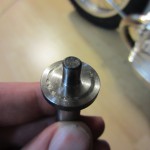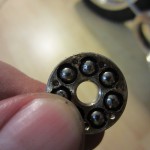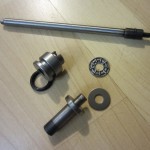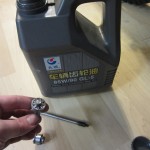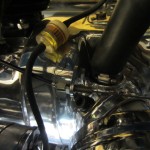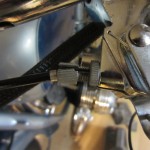September, 2013
After having the sidecar for about 2 months, and not many miles on it, I started having problems with the clutch. Having the clutch fully pulled (disengaged), and idling at a stoplight, it would lurch and jerk, and want to creep foward. Revving the engine slightly helped, but I knew there was something going bad. After talking with a few other guys about it, I was pretty sure it was the clutch throw-out bearing. This is a roller bearing that allows a stationary lever to push on the rotating elements of the clutch to disengage it. All manual transmissions have a similar mechanism.
On the sidecar, the left handle bar lever pulls a cable that goes down to the back of the transmission, where it pushes on a round button on the transmission.
The lever is fastened to a pivot that is part of a ring that clamps around this area. Loosening one bolt and the lever and pivot ring slide right off. From there, the button can be pulled out, as it is is sealed by an O-ring (this is one hard face of the bearing race), and that exposes the clutch throw-out bearing.
From there the ball bearing unit can be pulled out, a small screwdriver can be used to pop it out. Then there’s the other side of the bearing race that the ball bearing unit rides on and pushes on a shaft that goes through the transmission to the actual clutch. This can be grabbed with a needlenose pliers, and should slide right out.
Here’s the pieces, and how they look all together:
And now, here’s the main problem:
Notice the groove and divots in the 1st picture that are on the race of the bearing. Then look closely at the ball bearings in the second picture, you can see the galling on the balls, which wears heavily on the race. This is what is causing the bike to buck and lurch when the clutch is pulled. Given time, this bearing will completely shell out, causing total clutch failure where you would not be able to disengage the clutch. That would be particularly bad in the traffic in this city!!!
This ball bearing clutch bearing is not a particularly good design as there are extreme loads at the points where the balls contact the flat surface of the races. Fortunately, there’s a better design already available from Ben at www.sidecarpro.com
Notice that it is a roller bearing, which distributes the loads across more surface area, much better all the way around. The long shaft is to connect the clutch bearing to the actual clutch pack at the front of the transmission. I didn’t replace that shaft as its a pain to remove, and not really necessary.
Now to oil up the parts and prepare to reassemble:
Just some regular 85/90 weight gear lube oil is needed.
Then the assembly is the reverse of the disassembly, first the longer race piece goes in, then the flat washer, then the roller bearing and finally the outer race w/ o-ring.
At this point you’ll have to drastically loosen the clutch cable so that you can slip the lever and pivot ring back on and tighten it up. Then you can re-connect the clutch cable end, and adjust as needed at the lower and upper points. You’ll probably have to drive it a bit, and keep adjusting until it feels right!
Here’s the two adjustment areas for the cable:

